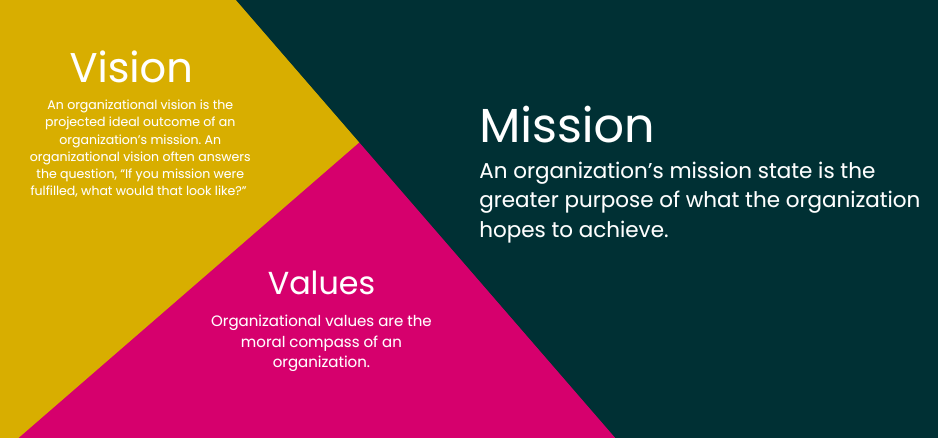“Effort and courage are not enough without purpose and direction.” John F. Kennedy
As the CEO of an association management company, I often get calls from people looking to begin non-profit organizations. I also receive requests from organizational leaders seeking assistance in growing their organization. My response is to ask each individual what their organization’s mission is. Very few can clearly articulate their mission, vision, or values. Without these, next steps and big-picture direction for an organization are impossible.
Over the past two decades, I have learned that an organization’s mission is the foundation to their success. Additionally, a clearly defined mission can spur growth and drive all actions of an organization. Because of this, it’s vital that every non-profit association has a clear mission with a vision and values to support that mission. This article will provide you with the roadmap to begin the process for your organization.
A Clearly Defined Mission Statement Example
The mission of the Schizophrenia International Research Society (SIRS) is to be a worldwide organization that aims to bring together researchers and clinicians in schizophrenia and related disorders to:
- Exchange the latest advances in research and facilitate the application of these findings to clinical practice and treatment.
- Promote the highest scientific and ethical standards in research.
- Commit to principles of fairness, equity, and actively promote diversity and inclusion in research.
- Advance international communication and collaboration in research.
- Cultivate the future of research in schizophrenia and related disorders by fostering the development of future generations of scientists.
- Increase the public understanding of the personal, familial, and societal impact on people with the diagnosis of schizophrenia and related disorders
Why do mission, vision, and values matter?
Developing a mission, vision, and organizational values for your society is the first step in building an organization’s value. We often refer to this as “a value proposition.” A value proposition is why members should join the organization and is a foundational step for developing a strategic plan. The value of an organization and the strategy for the short term must directly correlate back to the mission, vision and organizational values.
What is an organizational mission statement?
An organization’s mission state is the greater purpose of what the organization hopes to achieve. The most successful mission statements are concrete, clearly articulated, and easily understood.
When an organization leader is asked about their mission, their response should be the quickest elevator speech they know!
Why do mission, vision, and values matter?
Developing a mission, vision, and organizational values for your society is the first step in building an organization’s value. We often refer to this as “a value proposition.” A value proposition is why members should join the organization and is a foundational step for developing a strategic plan. The value of an organization and the strategy for the short term must directly correlate back to the mission, vision and organizational values.
What is an organizational mission statement?
An organization’s mission state is the greater purpose of what the organization hopes to achieve. The most successful mission statements are concrete, clearly articulated, and easily understood.
When an organization leader is asked about their mission, their response should be the quickest elevator speech they know!
What does an organization risk should they not form a clearly defined mission?
An organization without a clearly defined mission is like a hiker in a remote region with no map or compass. Like the hiker, an organization needs direction and a clear path to move forward and accomplish its goals. Without a clear mission or strategic plan, groups often end up chasing shiny objects that will seemingly offer direction, but in the end create a disparate approach to the real work the organization was established to accomplish.

What is an organizational vision?
An organizational vision is the projected ideal outcome of an organization’s mission. An organizational vision often answers the question, “If you mission were fulfilled, what would that look like?”
For example, the vision statement of SIRS it to “advance the understanding, research, prevention and treatment of schizophrenia and related disorders until they are no longer a cause of human suffering.”
This vision paints the picture of what their mission looks like in action—and being achieved.

What are organizational values?
Organizational values are the moral compass of an organization. While the vision and mission focus on achievement and success, values define the organization’s ethics. In other words, how the organization should act, how members should interact, and what the organization believes is right.
What is the relationship of an organization’s mission, values, and vision?
A mission is the overarching goal of the organization. The vision is what it looks like to achieve said goal. An organization’s values are the parameters for what actions are ethical within and on its behalf.
When combined, an organization’s mission, vision, and value provide a thorough roadmap for how every person involved in the organization should act in order to achieve their common goal—from board members to conference attendees.
Steps to Defining a Clear Organizational Mission, Vision, and Values
The best way to determine an organization’s mission, vision and values is to ask, “what is your organization’s reason for being – why does it exist?” However, answering that question isn’t always as simple as one may think. If your organization is working to define or redefine their mission, you will want to gather a small group of invested leaders or key members:
- To begin the process, write your reason for being in one paragraph.
- Next, drill that paragraph down, keeping in mind that you only want to retain the most vital elements of what impact your organization can have. For example, a paragraph describing PMG’s mission may include the idea that we play a vital role in helping our clients achieve their missions in order to make the world a better place for all now and into the future. However, making the world a better place is a bit abstract and is implied through mention of our clients’ missions. Additionally, the notion of a better world begins to verge into the area of an organizational vision, so we would strike this section out during this step.
- After spending time paring down your paragraph, you want to aim for a mission statement that is no more than two sentences long. The shorter the better. PMG’s mission statement is simple. “Our mission is to help our clients achieve their mission.” The shorter the statement the more impact it can elicit.
Defining Your Vision
Once you have determined your mission, it’s time to think bigger. In determining a vision, I tell groups that your mission is like looking down the road while your vision is like looking out the window. When you look out the window, you give yourself the opportunity to dream big.
During this phase, I challenge my groups to think bigger. Imagine if all obstacles were eliminated, what would be the outcome? Your answer to this question is your vision.
Vision statements are more aspirational than mission statements and may not be attainable in the near future but are still something the organization can set its sights on achieving. For example, PMG’s vision statement is: “PMG will be recognized as the premier AMC, achieving the highest client satisfaction scores, powered by our outstanding team.” It is a bit aspirational, but when I look out the window, this is what I daydream about.
Defining Organizational Values
Organizational values are the beliefs and values that guide all the organization’s activities. I often describe them as your organization’s decision filters. When making decisions on behalf of the organization, I encourage a board to run that decision through the lens of their organizational value statements. If one of the statements is contrary to the proposed decision, the board is not upholding that value and therefore should not follow through acting upon it.
How can an organization develop their values? Do they seek member input?
Core values are the lens in which all decisions should be made through. When making a significant decision for the organization, the core values should be consulted. Creating, reviewing and updating core values should be conducted at the same time the review of the mission is done. Typically, a strategic planning committee or a Board can determine these core values.
What are some examples of organizational values?
You will notice that values often reflect large, ethical, abstract concepts, such as “fairness.” This can leave room for interpretation. However, most reasonable people can agree upon the meaning of these concepts, and it is the role of the board to interpret the meaning when applied to potential actions.
Below is an example of one of our client’s organizational values.
- Commitment to Excellence
- Commitment to Integrity
- Commitment to Openness
- Commitment to Clinical/Basic Exchange among Academic, Government and Industry Scientists
- Commitment to Education and Training
- Commitment to Collegiality
- Commitment to Diversity
- Commitment to Research Ethics
I use these values on agendas and in cards that are placed at each board members’ seat during a meeting to remind them of the filter for all decisions.
How does defining organizational values differ for a for-profit/non-profit association?
All groups’ organizational values are unique to them, whether they are a for-profit organization or a non-profit association. However, associations bring people together, and this makes defining their values vital to the health and longevity of their organization. Without values, the measure of ‘who we are’ becomes fuzzy and can dilute the organization’s identity and ‘rule of engagement.’ With the rotation of boards and committees, having these rules of engagement clearly defined creates stability and continuity through transitions.
For non-profits, values streamline messaging and provide the board with guidance on how to navigate the decision-making landscape.
Strategic planning can bring to light areas for organizational improvement
One of the greatest advantages of going through the mission, vision, and values process is that it allows you to step back and see your organization from a different perspective.
I recently was engaged by the State Government Affairs Council to offer a governance review and strategic plan. The work of this organization had been primarily led by the board and staff. Through the strategic planning process, we set forth a three-year plan with clear strategies for year one. In identifying those strategies, it became clear the need for further committee engagement and participation in completing the strategic objectives. Committee descriptions and work plans were updated and distributed, and the organization is now working toward their year one operational plan of the strategic plan.
What are some signs that your organization is due for a mission revision?
I encourage our organizations to examine their mission, vision, organizational values and value proposition annually. Most years no changes are made to these statements, but reviewing them is foundational to a board of directors’ focus for the year in order to grow the organization.
However, an organization is due for a mission revision every 3 to 5 years. Our environments change, membership changes, trends shift, and agile organizations shift with these changes. It is important to be attuned to our cultural changes while still being true to the mission the organization was originally established to do. If you have not had a mission revision since the pandemic, the time is now!

Mission, Vision, and Values: Your Roadmap to Success
A clearly defined mission, vision, and values are the cornerstones of a successful organization. They provide a roadmap, guiding decision-making, and aligning efforts towards a shared goal. By understanding and embracing these essential elements, organizations can foster a sense of purpose, attract like-minded individuals, and navigate challenges with confidence.
Remember, a mission, vision, and values are not static; they should be revisited and refined periodically to ensure they remain relevant and inspiring. By investing time and effort into developing and maintaining these foundational components, organizations can set themselves up for long-term success and make a lasting impact


